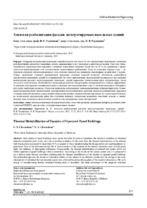| dc.contributor.author | Черноиван, В. Н. | |
| dc.contributor.author | Черноиван, Н. В. | |
| dc.coverage.spatial | Минск | ru |
| dc.date.accessioned | 2022-12-09T13:20:18Z | |
| dc.date.available | 2022-12-09T13:20:18Z | |
| dc.date.issued | 2022 | |
| dc.identifier.citation | Черноиван, В. Н. Тепловая реабилитация фасадов эксплуатируемых панельных зданий = Thermal Rehabilitation of Facades of Operated Panel Buildings / В. Н. Черноиван, Н. В. Черноиван // Наука и техника. – 2022. – № 6. – С. 511-516. | ru |
| dc.identifier.uri | https://rep.bntu.by/handle/data/123528 | |
| dc.description.abstract | Натурные исследования панельных зданий показали, что после 30 лет эксплуатации техническое состояние конструктивных элементов (закладные детали, сварные швы и др.) находятся в рабочем состоянии. При этом теплотехнические характеристики наружного стенового ограждения снизились более чем на 30 % по сравнению с принятыми при проектировании и не соответствуют нормативным требованиям. Одна из основных причин этого – деструкция материала теплоизоляционного слоя стеновых панелей под влиянием атмосферных воздействий. Следовательно, проведение тепловой реабилитации наружных стеновых панелей позволяет обеспечить дальнейшую эксплуатацию панельных зданий без ограничений. По итогу выполненных исследований предлагается для тепловой реабилитации фасадов эксплуатируемых панельных зданий применить теплоизоляционную облицовочную плиту заводского изготовления. В публикации приведены результаты лабораторных экспериментов по выбору эффективного решения конструкции соединения (стыка) отдельных теплоизоляционных плит в теплоизоляционную облицовочную плиту требуемых размеров. Изложена технология изготовления теплоизоляционных облицовочных плит. Основными преимуществами предлагаемого конструктивно-технологического решения тепловой реабилитации наружных стеновых панелей являются: существенное сокращение ручных технологических процессов на строительной площадке, возможность производства работ без отселения жильцов, исключение появления «мостиков холода» в межпанельных швах в процессе эксплуатации зданий за счет применения стыка типа фолдинг. | ru |
| dc.language.iso | ru | ru |
| dc.publisher | БНТУ | ru |
| dc.title | Тепловая реабилитация фасадов эксплуатируемых панельных зданий | ru |
| dc.title.alternative | Thermal Rehabilitation of Facades of Operated Panel Buildings | ru |
| dc.type | Article | ru |
| dc.identifier.doi | 10.21122/2227-1031-2022-21-6-511-516 | |
| local.description.annotation | Field studies of panel buildings have shown that after 30 years of operation, the technical condition of structural elements (embedded parts, welds, etc.) are in working condition. At the same time, the thermal characteristics of the external wall fencing have decreased by more than 30 % compared to those adopted during the design and do not meet regulatory requirements. One of the main reasons for this is the destruction of the material of the thermal insulation layer of wall panels under the influence of atmospheric influences. Consequently, the thermal rehabilitation of external wall panels allows for further operation of panel buildings without restrictions. According to the results of the studies carried out, it is proposed to use a factory-made thermal insulation cladding plate for thermal rehabilitation of the facades of operated panel buildings. The publication presents the results of laboratory studies on the choice of an effective solution for the design of the conection (joint) of individual thermal insulation plate into a thermal insulation facing plate of the required dimensions. The technology of manufacturing thermal insulation facing plates is described. The main advantages of the proposed structural and technological solution for the thermal rehabilitation of external wall panels are: a significant reduction in manual technological processes on the construction site; the possibility of performing work without eviction of residents; eliminating the appearance of cold bridges in the inter-panel seams during the operation of buildings through the use of a folding type joint. | ru |

